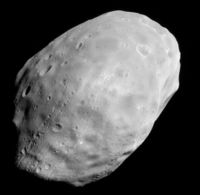Difference between revisions of "Phobos"
m (inc orbital para) |
m (tidied and added links) |
||
| Line 1: | Line 1: | ||
| − | |||
| − | |||
[[Image:Phobos_MGS.jpg|thumb|200px|right|A [[Mars Global Surveyor]] image of the moon Phobos.]] | [[Image:Phobos_MGS.jpg|thumb|200px|right|A [[Mars Global Surveyor]] image of the moon Phobos.]] | ||
| + | '''Phobos''' is a dark body that appears to be composed of carbonaceous surface materials. Phobos' density is too low to be pure rock, however, and it is known to have significant porosity. These results led to the suggestion that Phobos might contain a substantial reservoir of ice, but spectral observations have ruled out this hypothesis. | ||
| − | + | The Soviet spacecraft [[Phobos 2]] reported a faint but steady release of dust particles from Phobos, but the spacecraft failed before it could determine the nature of the material. Recent images from [[Mars Global Surveyor]] indicate that Phobos is covered with a layer of fine-grained [[regolith]] at least 100 metres thick; it is believed to have been created by impacts from other bodies, but it is not known how the material stuck to an object with almost no gravity. | |
| − | |||
| − | |||
| − | The Soviet spacecraft Phobos 2 reported a faint but steady release of dust particles from Phobos, but the spacecraft failed before it could determine the nature of the material. Recent images from Mars Global Surveyor indicate that Phobos is covered with a layer of fine-grained regolith at least 100 metres thick; it is believed to have been created by impacts from other bodies, but it is not known how the material stuck to an object with almost no gravity. | ||
Phobos is highly nonspherical, with dimensions of 27 × 21.6 × 18.8 km. Because of its shape alone, the gravity on its surface varies by about 210%; the tidal forces raised by Mars more than double this variation (to about 450%) because they compensate for a little more than half of Phobos' gravity at its sub- and anti-Mars poles. | Phobos is highly nonspherical, with dimensions of 27 × 21.6 × 18.8 km. Because of its shape alone, the gravity on its surface varies by about 210%; the tidal forces raised by Mars more than double this variation (to about 450%) because they compensate for a little more than half of Phobos' gravity at its sub- and anti-Mars poles. | ||
Deimos' orbit has an [[eccentricity]] of 0.0151 with an [[apoareion]]) of 9518.8km.<ref>[http://en.wikipedia.org/wiki/Phobos_%28moon%29 Wikipedia entry for Phobos.]</ref> | Deimos' orbit has an [[eccentricity]] of 0.0151 with an [[apoareion]]) of 9518.8km.<ref>[http://en.wikipedia.org/wiki/Phobos_%28moon%29 Wikipedia entry for Phobos.]</ref> | ||
| + | |||
| + | ==References== | ||
| + | <references/> | ||
[[Category:Natural_Satellites]] | [[Category:Natural_Satellites]] | ||
Revision as of 00:04, 8 October 2007

Phobos is a dark body that appears to be composed of carbonaceous surface materials. Phobos' density is too low to be pure rock, however, and it is known to have significant porosity. These results led to the suggestion that Phobos might contain a substantial reservoir of ice, but spectral observations have ruled out this hypothesis.
The Soviet spacecraft Phobos 2 reported a faint but steady release of dust particles from Phobos, but the spacecraft failed before it could determine the nature of the material. Recent images from Mars Global Surveyor indicate that Phobos is covered with a layer of fine-grained regolith at least 100 metres thick; it is believed to have been created by impacts from other bodies, but it is not known how the material stuck to an object with almost no gravity.
Phobos is highly nonspherical, with dimensions of 27 × 21.6 × 18.8 km. Because of its shape alone, the gravity on its surface varies by about 210%; the tidal forces raised by Mars more than double this variation (to about 450%) because they compensate for a little more than half of Phobos' gravity at its sub- and anti-Mars poles.
Deimos' orbit has an eccentricity of 0.0151 with an apoareion) of 9518.8km.[1]






